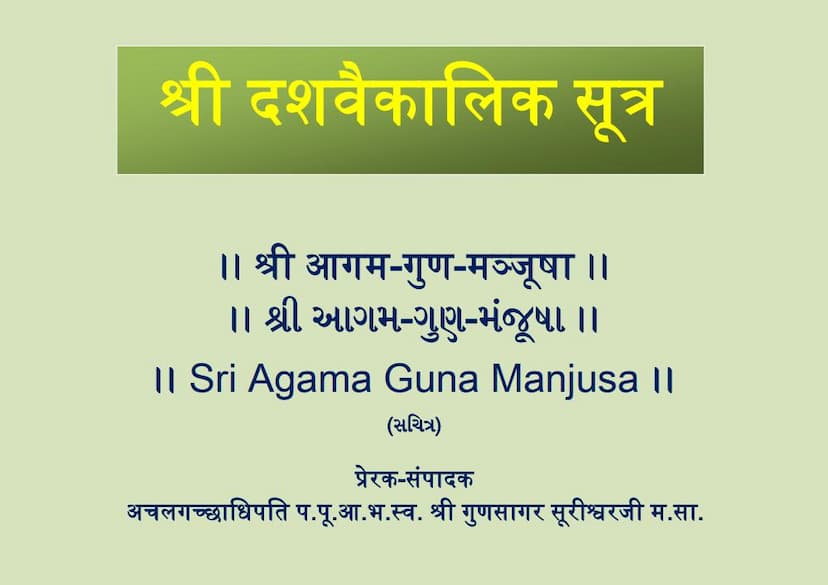Agam 42 Mool 03 Dashvaikalik Sutra Shwetambar Agam Guna Manjusha
Added to library: September 1, 2025

Summary
This document is a detailed overview of the Jain Agamas, specifically focusing on "Agam 42 Mool 03 Dashvaikalik Sutra Shwetambar Agam Guna Manjusha" authored by Gunsagarsuri. It appears to be part of a larger series called "Agam Guna Manjusha," aiming to provide a comprehensive introduction to the 45 Agamas.
The text systematically categorizes and describes the various Jain scriptural texts, including:
I. Eleven Angas:
- Acharanga Sutra: Focuses on the conduct of monks and householders, with the teaching of conduct being the main topic.
- Suyagadanga Sutra (Sutra-Kritanga): Discusses the views of various doctrine-holders and emphasizes the teaching of entity.
- Thapanga Sutra: Primarily deals with calculation, but also touches upon other teachings. It describes objects from one to eight.
- Samavāyānga Sutra: A compendium listing objects from one to crores.
- Vyakhyā-prajñapti Sutra (Bhagavati Sutra): The largest Agama, described as a treasure of gems, containing questions and answers between Lord Mahavira and Gautama Ganadhara, covering all four teachings.
- Jātādharma Kathānga Sutra: Deals with religious discourses and contains numerous religious discourses.
- Upāsaka-daśānga Sutra: Explains the 12 vows and the life-sketches of 10 great Jain householders.
- Praśna-vyākaraṇa Sutra: Primarily focuses on the teaching of conduct, detailing Lord Mahavira's answers to questions and the paths leading to transgression and self-control.
- Vipāka Sutra: Consists of two parts, narrating the stories of 10 sinful and 10 virtuous souls.
II. Twelve Upangas:
- Uvavayi Sutra: Subservient to Acharanga Sutra, describing Campa city, austerities, and disciples.
- Rayapaseni Sutra: Subservient to Suyagadanga Sutra, depicting king Pradesi's jurisdiction and the worship of Jina idols.
- Jivabhigama Sutra: Subservient to Thanaanga Sutra, analyzing self and non-self, and describing veneration practices.
- Pannāvaṇā Sutra: Subservient to Samavāyānga Sutra, describing 36 steps or topics.
- Surya-prajñapti Sutra & Chandra-prajñapti Sutra: Focus on calculation, describing solar and lunar transits and astronomical phenomena.
- Jambudvipa-prajñapti Sutra: Also focuses on calculation, providing a detailed description of the Jambu continent.
- Nirayavali Sutra, Kalpavatamsaka Sutra, Pupphiya-upanga Sutra, Pupphaculiya-upanga Sutra, Vahnidaśā-upanga Sutra: These five are collectively known as Nirayavali Pancaka and deal with various life-sketches and narratives.
III. Ten Payanna Sutras: These deal with various aspects of religious practice, final atonement, and the nature of death. Some of these can be studied by householders as well.
IV. Six Cheda Sutras:
- Nishitha Sutra, Mahanishitha Sutra, Vyavahara Sutra, Jitakalpa Sutra, Panchakalpa Sutra, Dasha Shruta-skandha Sutra: These deal with rules, exceptions, and confession. Their study is restricted to highly qualified monks.
V. Four Moola Sutras:
- Dashavaikalika Sutra: Considered like a nectar lake for monks and nuns in the fifth stage, containing 10 lessons and two concluding sections (Chulikas).
- Uttaradhyayana Sutra: Contains the last sermons of Lord Mahavira, discussing detachment and monastic conduct across 36 lessons.
- Niryukti Sutra: Discusses aspects of conduct and behavior, including methods of receiving food and avoiding faults.
- Avashyaka Sutra: Essential for all four groups of the Jain community, describing six obligatory daily duties.
VI. Two Chulikas:
- Nandi Sutra: Contains hymns, comparisons for the religious community, lists of Tirthankaras and Ganadharas, and a description of five types of knowledge.
- Anuyogadvāra Sutra: Considered the key to all Agamas, it teaches the path of worship through firm resolve and worldly involvements, explaining different types of explanatory devices.
The document also provides the approximate number of verses (Slokas) for many of these texts and emphasizes the author, Gunsagarsuri, and the publisher, Jina Goyam Guna Sarvoday Trust Mumbai. The overall aim is to provide a concise introduction to the vast body of Jain Agamic literature. The title "Agam Guna Manjusha" translates to "Jewel Casket of Agama Qualities," suggesting the series aims to highlight the virtues and contents of these sacred texts.
The later pages (starting from Page 8 onwards) delve into the specific structure and content of the Dashavaikalika Sutra itself, detailing its 10 chapters (Adhyayanas) and their respective themes. It also includes a significant portion of the Ogha Niryukti and Pindaniryukti in Prakrit, which are Niryuktis associated with the four Moola Sutras, providing technical details on monastic conduct, rules, and practices. These Prakrit sections are quite extensive and technical, discussing various situations, prohibitions, and guidelines for monks.